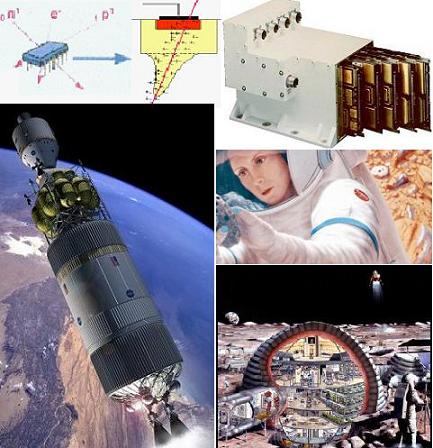NASA researchers are developing advanced computers that can think clearly even when bombarded with radiation in space
Avi Blizovsky

In the photo: top left: how space radiation damages computer processors. Right: EAFTC's triple solution. Below - a selection of environments in which the computers will operate - in a spaceship, on Mars and the moon
When your computer goes crazy, corrupts your data or just crashes completely, it can be frustrating but for astronauts who rely on the computer to navigate their spaceship and monitor the life support system, computer malfunctions can be fatal (who doesn't remember the God computer in the movie 2001 A Space Odyssey .
Unfortunately, the radiation flooding space can cause such malfunctions. When particles arriving at high speed such as cosmic rays collide with the microscopic wiring of computer chips, they can cause the chip to make mistakes. If these malfunctions cause the spacecraft to deviate from its orbit or interfere with the functioning of the life support system, this could be bad news.
To ensure the safety of the flight, the astronauts use computers whose chips are hardened against radiation. "Rad-hard" chips differ from normal chips in many ways. For example, they contain excess transistors and therefore require more energy to turn the computer on and off. The cosmic rays cannot change their fields (from zero to one or vice versa) so easily. Radiation-hardened chips will continue to perform accurate calculations where normal chips might go crazy.
NASA relies exclusively on these hardened chips to perform calculations in space, but these specially made chips have several drawbacks. First, they are expensive, second, they consume a lot of energy, and third, they are slow, 10 times slower than the equivalent CPU in modern home computers.
When NASA sends humans to the moon and Mars, the designers of the spacecraft that will carry them will be happy that their computers will have more horse power.
Stronger processing power in the spaceship will make it possible to maintain the most limited resource - bandwidth. Bandwidth available to transmit data back to Earth is often a bottleneck, with transmission rates slower than even old dial-up modems. If all the raw data collected by the spacecraft's sensors can be processed on board, scientists can pull only the processing results from them, which will require much less bandwidth.
On the surface of the Moon or Mars, the astronauts will be able to use high-speed computers to analyze the data after it is collected, quickly identifying areas of scientific interest and possibly collecting additional data to exploit opportunities before they pass. Even robotic space vehicles will be able to benefit from the excess intelligence of modern processors.
Using the same inexpensive processors - whether they are Pentium or Power PC processors used for personal computers, will be a considerable improvement, provided that the problem of errors caused by radiation is solved.
This is where a new NASA project called Environmentally Adaptive Fault-Tolerant Computing (EAFTC) comes into play. The researchers are currently working on the project trying ways to use ordinary processors in space missions. They are particularly interested in "single event upsets," the most common type of failure caused by a single radiation particle penetrating the chip.
Team member Raphael Some from JPL explains: "One way to use commercial processors in space is to simply use three processors. If one processor makes a radiation-induced error, the other two can still agree, and by majority decision give the correct answer.
This will work but there is still the problem of wasting energy on computing power to triple check every calculation that will not always be critical.
"To do this in a smarter and more efficient way, we are developing software that will consider the importance of the calculation" says Sam. "If it is an important calculation like navigation, all three processors must vote. If it is a less critical calculation such as measuring the chemical composition of a rock, one or two processors can suffice.
However, this is only one of dozens of error correction techniques that the EAFTC will use. The result is greater efficiency. Without the EAFTC software, a computer based on consumer processors would require 100-200 percent redundancy to protect against radiation errors. With EAFTC, an excess of 15-20 percent is sufficient to obtain the same degree of coverage. All the saved processing time can be used for more productive applications.
"EAFTC is not going to replace the hardened processors." Sam explains. "There will be tasks like supporting the existence of life that are so important that we will always want hardened chips to run them. However, the algorithms we developed for EAFTC can also help ease the processing load on these computers, thus increasing the computing power available to the astronauts."
The first EAFTC experiment will be aboard a satellite known as Space Technology 8 (ST-8), which belongs to NASA's Millennium Program. ST-8 will be used to test new technologies and the lessons learned from it will be used to plan future space missions when there is more confidence in the technology.
The satellite, planned for launch in 2009, will cross the Van Allen Belt throughout the elliptical orbit of the Earth and will test the EAFTC under strong radiation conditions similar to those in deep space. If all goes well, spacecraft that will cross the solar system will be able to use the exact same chips as those in our personal computers - only without the malfunctions.
For information on the NASA website
The knowledge of man and space
https://www.hayadan.org.il/BuildaGate4/general2/data_card.php?Cat=~~~323039534~~~80&SiteName=hayadan
